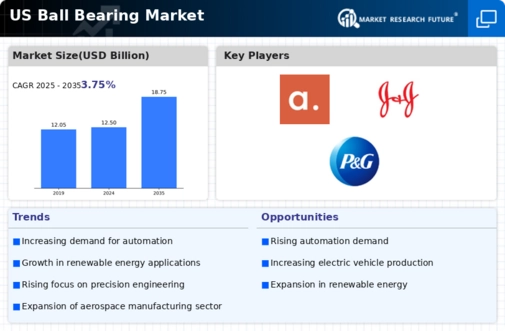Industrial Automation Growth
The trend towards industrial automation is significantly influencing the ball bearing market. As manufacturers in the US adopt advanced automation technologies, the need for reliable and efficient ball bearings becomes paramount. The market for industrial automation is expected to reach $300 billion by 2026, with ball bearings being integral to the operation of automated machinery. These components enhance precision and reduce friction, thereby improving overall productivity. Furthermore, the increasing adoption of robotics in manufacturing processes necessitates high-performance ball bearings, which are designed to withstand rigorous operational demands. Thus, the ball bearing market is poised for growth as automation continues to reshape manufacturing landscapes.
Rising Automotive Production
The automotive sector plays a pivotal role in the ball bearing market. As vehicle production in the US continues to rise, the demand for high-quality ball bearings is expected to increase correspondingly. In 2025, the automotive industry is projected to contribute approximately $1 trillion to the US economy, with a significant portion allocated to components like ball bearings. These components are essential for ensuring smooth operation and longevity of vehicles. The increasing focus on electric vehicles (EVs) further amplifies this demand, as EVs require specialized ball bearings to handle unique operational challenges. Consequently, the ball bearing market is likely to experience robust growth driven by the automotive sector's expansion.
Expansion of Renewable Energy Sector
The renewable energy sector is emerging as a significant driver for the ball bearing market. With the US government promoting clean energy initiatives, investments in wind and solar energy are on the rise. Wind turbines, for instance, rely heavily on high-quality ball bearings to ensure efficient operation and durability. The US wind energy market is projected to grow by 20% annually, creating a substantial demand for specialized ball bearings. These components are crucial for minimizing friction and wear in turbine operations, thereby enhancing energy efficiency. As the renewable energy sector expands, the ball bearing market is likely to benefit from increased demand for these essential components.
Technological Innovations in Manufacturing
Technological innovations in manufacturing processes are reshaping the ball bearing market. Advanced manufacturing techniques, such as additive manufacturing and precision machining, are enabling the production of high-performance ball bearings with enhanced properties. These innovations allow for the creation of lighter, stronger, and more durable bearings, which are essential for various applications across industries. The US manufacturing sector is expected to invest over $400 billion in technology upgrades by 2026, which will likely include advancements in ball bearing production. As manufacturers seek to improve efficiency and reduce costs, the ball bearing market stands to gain from these technological advancements.
Increased Focus on Maintenance and Reliability
The growing emphasis on maintenance and reliability in industrial operations is driving demand in the ball bearing market. Companies are increasingly recognizing the importance of preventive maintenance to avoid costly downtimes. This trend is particularly evident in sectors such as manufacturing and aerospace, where the failure of a single component can lead to significant operational disruptions. The US maintenance, repair, and operations (MRO) market is projected to reach $200 billion by 2025, highlighting the increasing investment in maintenance solutions. As organizations prioritize reliability, the ball bearing market is likely to see heightened demand for high-quality bearings that ensure optimal performance and longevity.














Leave a Comment